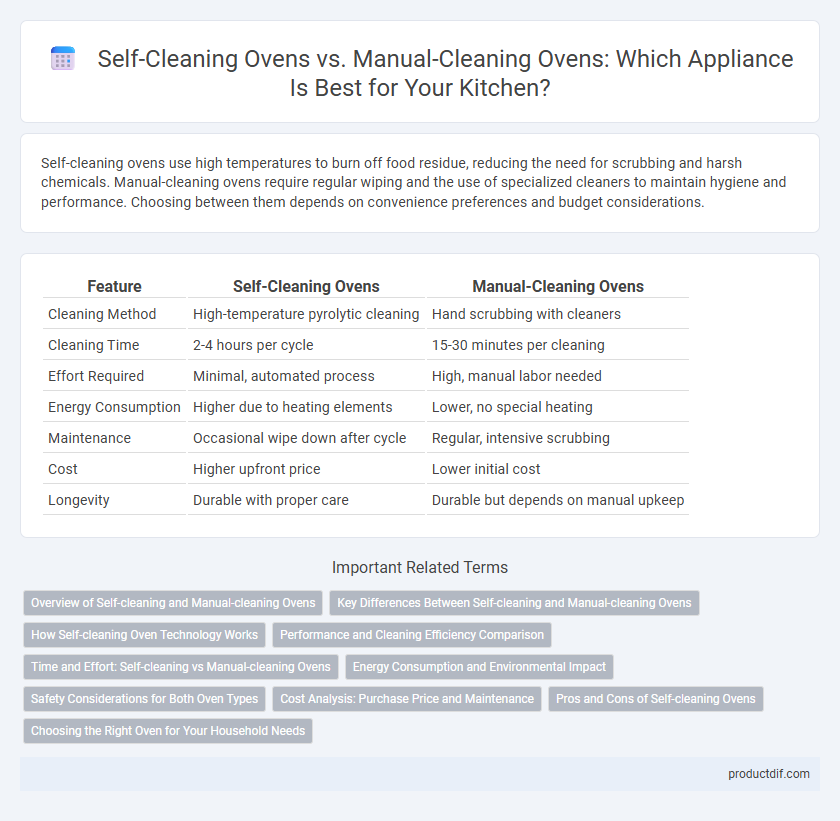Self-cleaning ovens use high temperatures to burn off food residue, reducing the need for scrubbing and harsh chemicals. Manual-cleaning ovens require regular wiping and the use of specialized cleaners to maintain hygiene and performance. Choosing between them depends on convenience preferences and budget considerations.
Table of Comparison
| Feature | Self-Cleaning Ovens | Manual-Cleaning Ovens |
|---|---|---|
| Cleaning Method | High-temperature pyrolytic cleaning | Hand scrubbing with cleaners |
| Cleaning Time | 2-4 hours per cycle | 15-30 minutes per cleaning |
| Effort Required | Minimal, automated process | High, manual labor needed |
| Energy Consumption | Higher due to heating elements | Lower, no special heating |
| Maintenance | Occasional wipe down after cycle | Regular, intensive scrubbing |
| Cost | Higher upfront price | Lower initial cost |
| Longevity | Durable with proper care | Durable but depends on manual upkeep |
Overview of Self-cleaning and Manual-cleaning Ovens
Self-cleaning ovens utilize high temperatures between 800degF and 900degF to incinerate food residues into ash, simplifying maintenance and reducing the need for harsh chemicals. Manual-cleaning ovens require regular scrubbing with cleaning agents to remove baked-on grease and spills, demanding more time and physical effort from users. The self-cleaning function enhances convenience and safety by sealing the oven door during the cleaning cycle, preventing exposure to fumes.
Key Differences Between Self-cleaning and Manual-cleaning Ovens
Self-cleaning ovens feature a high-temperature pyrolytic cycle that reduces food residue to ash, minimizing user effort and harsh chemical use, while manual-cleaning ovens require regular scrubbing and chemical cleaners to maintain cleanliness. Self-cleaning models often include safety locks and insulated doors to prevent burns during the cleaning cycle, unlike manual-cleaning ovens which have no built-in safety mechanisms for cleaning. Energy consumption is higher during the self-cleaning process, but these ovens provide superior convenience and longer-lasting cleanliness compared to manual-cleaning ovens.
How Self-cleaning Oven Technology Works
Self-cleaning ovens use high-temperature pyrolytic cleaning cycles reaching up to 900degF (482degC) to incinerate food residues and grease into ash, which can be easily wiped away. This technology often incorporates insulated oven walls and advanced sensors to maintain safety and optimize energy use during the cleaning process. Compared to manual-cleaning ovens, self-cleaning models reduce the need for harsh chemicals and extensive scrubbing, offering a more convenient and hygienic cleaning solution.
Performance and Cleaning Efficiency Comparison
Self-cleaning ovens utilize high-temperature pyrolytic cycles to effectively burn off food residues, significantly reducing manual scrubbing and eliminating most grease and baked-on spills. Manual-cleaning ovens rely on chemical cleaners and physical effort, often leaving behind stubborn stains and requiring frequent maintenance to maintain optimal performance. The self-cleaning technology enhances long-term oven efficiency by preventing residue buildup that can impair heating elements and airflow.
Time and Effort: Self-cleaning vs Manual-cleaning Ovens
Self-cleaning ovens significantly reduce the time and effort required to maintain cleanliness by using high temperatures to burn off food residues, eliminating the need for scrubbing. Manual-cleaning ovens demand considerable time and physical effort to remove grease and baked-on food, often requiring harsh chemicals and elbow grease. Choosing self-cleaning models streamlines maintenance, saving hours of labor per cleaning cycle compared to traditional manual methods.
Energy Consumption and Environmental Impact
Self-cleaning ovens use high temperatures to burn off residues, which typically consumes more energy per cycle compared to manual-cleaning ovens that rely on user effort for maintenance. Manual-cleaning ovens require chemical cleaners that can release volatile organic compounds (VOCs), impacting indoor air quality and contributing to environmental pollution. Choosing between these types impacts both household energy consumption and the ecological footprint associated with cleaning methods and emissions.
Safety Considerations for Both Oven Types
Self-cleaning ovens feature high-temperature cycles that effectively reduce grease and food residue but require safety precautions to avoid burns and prevent smoke inhalation during the cleaning process. Manual-cleaning ovens demand the use of chemical cleaners or scrubbing tools, which can expose users to harsh fumes and increase the risk of skin irritation or injury. Proper ventilation, protective gloves, and adherence to manufacturer guidelines are essential safety measures for both self-cleaning and manual-cleaning oven maintenance.
Cost Analysis: Purchase Price and Maintenance
Self-cleaning ovens generally have a higher purchase price, often ranging from $800 to $2,000, compared to manual-cleaning ovens priced between $400 and $1,200. Maintenance costs for self-cleaning ovens tend to be lower due to built-in pyrolytic cleaning cycles that reduce the need for chemical cleaners and frequent manual scrubbing. Manual-cleaning ovens require ongoing expenses for cleaning supplies and potentially more labor, which can increase total cost of ownership over time.
Pros and Cons of Self-cleaning Ovens
Self-cleaning ovens use high temperatures to burn off food residues, reducing the need for harsh chemicals and extensive scrubbing while saving time and effort. However, these ovens consume more energy during the cleaning cycle and can emit unpleasant odors or smoke, requiring proper ventilation. The self-cleaning feature may also increase the appliance's initial cost and potentially cause wear on oven components over time.
Choosing the Right Oven for Your Household Needs
Self-cleaning ovens use high temperatures to incinerate food residue, reducing effort and chemical usage, making them ideal for busy households seeking convenience. Manual-cleaning ovens require scrubbing and specialized cleaners but often cost less and allow for more control over cleaning frequency and methods. Assess household cooking habits, budget, and maintenance preferences to choose the oven that best suits your lifestyle and cleaning priorities.
Self-cleaning Ovens vs Manual-cleaning Ovens Infographic

 productdif.com
productdif.com